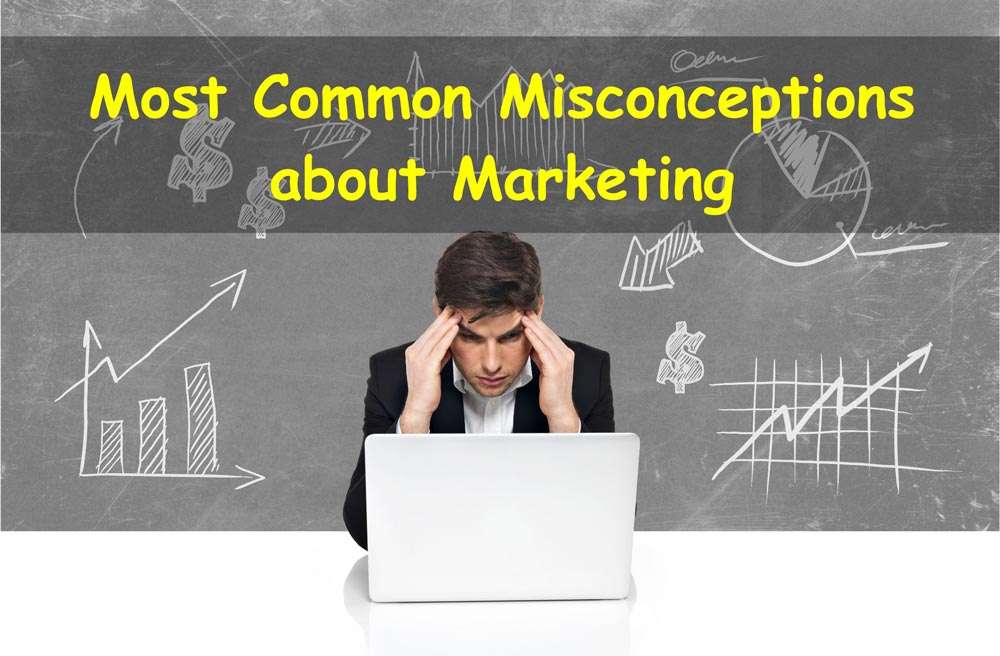Marketing is a dynamic and ever-evolving field, driven by changes in consumer behavior, technology, and market trends. As businesses strive to stay competitive and relevant, it’s crucial to have a clear understanding of marketing principles. Unfortunately, there are several common misconceptions that persist in the world of marketing. These misconceptions can hinder a company’s ability to create effective marketing strategies and achieve its goals. In this comprehensive article, we will explore the most common marketing misconceptions and provide actionable insights on how to overcome them.
Marketing Misconceptions and How to Correct such Misconceptions in Marketing
Misconception 1: Marketing is All About Selling
One of the most pervasive misconceptions about marketing is the belief that its sole purpose is to sell products or services. While selling is undoubtedly an essential aspect of marketing, it’s only a part of the broader picture. Effective marketing involves building relationships with customers, understanding their needs, and delivering value beyond just the transaction.
Overcoming Misconception 1:
1. Shift from Selling to Storytelling: Instead of focusing solely on sales pitches, create compelling narratives that resonate with your target audience. Share stories that highlight the benefits of your product or service in solving real-life problems.
2. Emphasize Value and Benefits: Highlight the unique value propositions and benefits your product or service offers. Show how it can improve customers’ lives or address their pain points.
3. Build Trust: Trust is a fundamental element of any successful marketing strategy. Customer reviews can be used to build trust and enhance credibility.
Misconception 2: More Marketing Channels Mean Better Results
In today’s digital age, there is an abundance of marketing channels available, from social media and email marketing to content marketing and paid advertising. While having multiple channels at your disposal can be advantageous, spreading your resources too thin across all of them can lead to subpar results.
Overcoming Misconception 2:
1. Audience Research: Conduct thorough audience research to understand where your target audience spends their time. Focus your efforts on the channels that are most relevant to your audience.
2. Quality over Quantity: It’s better to excel on a few channels than to be mediocre on many. Providing high-quality content is essential in increasing engagement on selected platforms.
3. Continuous Evaluation: Regularly assess the performance of your marketing channels and adjust your strategy accordingly. Don’t hesitate to shift resources away from underperforming channels.
Misconception 3: Marketing is a One-Time Effort
Some businesses approach marketing as a one-time effort, often tied to the launch of a new product or business. This misconception can lead to missed opportunities and a failure to build a lasting brand presence.
Overcoming Misconception 3:
1. Long-Term Strategy: Develop a comprehensive, long-term marketing strategy that includes ongoing efforts to maintain brand visibility and engagement.
2. Consistency is Key: Consistency in messaging, branding, and customer engagement is crucial. Maintain a regular posting schedule and keep your audience informed about your offerings.
3. Customer Retention: Remember that marketing isn’t just about acquiring new customers but also retaining existing ones. Implement customer loyalty programs and nurture existing customer relationships.
Misconception 4: Marketing is Expensive
Many small businesses believe that effective marketing requires a substantial budget, making it seem unattainable. While a healthy marketing budget can certainly help, there are numerous cost-effective strategies that can yield significant results.
Overcoming Misconception 4:
1. Focus on ROI: Instead of fixating on the cost of marketing, pay attention to the return on investment (ROI). Calculate the revenue generated from marketing efforts to determine their effectiveness.
2. Leverage Digital Marketing: Digital marketing, including social media and content marketing, often provides a cost-effective way to reach a wide audience without breaking the bank.
3. DIY vs. Outsourcing: Consider whether certain marketing tasks can be handled in-house by existing team members. Outsourcing specific marketing functions can also be cost-effective.
Misconception 5: Marketing is Only for Big Brands
It’s a common misconception that marketing is primarily for large, established brands with extensive budgets. Small businesses and startups often assume they can’t compete in the marketing arena, which couldn’t be further from the truth.
Overcoming Misconception 5:
1. Niche Targeting: Small businesses can excel by targeting niche markets that may be overlooked by larger competitors. Tailor your marketing efforts to meet the unique needs of your niche audience.
2. Storytelling and Authenticity: Leverage your status as a small business to your advantage by emphasizing your authenticity and personal touch. Customers often appreciate the personal connection that smaller businesses can provide.
3. Smart Budget Allocation: While you may not have the budget of a big brand, you can still allocate your resources effectively. Focus on strategies that offer the most value for your specific business.
Misconception 6: All You Need is a Great Product
While having a quality product or service is undeniably important, it’s a misconception to believe that a superior offering alone will guarantee success. In a crowded market, even the best products need effective marketing to reach their audience.
Overcoming Misconception 6:
1. Market Research: Understand your target audience’s pain points, preferences, and behaviors. Tailor your marketing to address their specific needs and concerns.
2. Competitor Analysis: Study your competitors and identify gaps in their marketing strategies. Use this information to differentiate your offering effectively.
3. Effective Communication: Develop clear, persuasive messaging that highlights the unique features and benefits of your product or service. Show how it solves problems or enhances customers’ lives.
Misconception 7: Marketing is Only for Acquiring Customers
While acquiring new customers is a significant goal of marketing, it’s not the only one. Customer retention and loyalty are equally important, as it’s often more cost-effective to retain existing customers than to acquire new ones.
Overcoming Misconception 7:
1. Customer Journey Mapping: Understand the entire customer journey, from awareness to post-purchase engagement. Implement strategies to nurture and retain customers at each stage.
2. Personalization: Use data and insights to personalize your marketing efforts. Tailor your messages, offers, and content to individual customer preferences.
3. Loyalty Programs: Building a community of loyal customers can be a powerful marketing tool.
Interesting Facts about Marketing
Marketing is a dynamic and fascinating field that encompasses a wide range of strategies, techniques, and concepts. Here are some interesting facts about marketing:

1. Coca-Cola’s Logo: The Coca-Cola logo is recognized by 94% of the world’s population. This illustrates the power of branding and effective marketing in creating global recognition.
2. First Online Banner Ad: The first-ever online banner ad was displayed in 1994 on HotWired.com. It had a click-through rate (CTR) of 44%, a far cry from today’s average CTRs.
3. The Rule of Seven: It’s a marketing belief that potential customers need to see or hear about a product or service at least seven times before they take action. Repetition and consistency in marketing are key.
4. Apple’s 1984 Super Bowl Ad: Apple’s iconic “1984” Super Bowl commercial, introducing the Macintosh computer, is considered one of the greatest ads of all time. It aired only once on national television but generated immense buzz.
5. Color Psychology: Brands carefully select colors for their logos and marketing materials based on color psychology. For instance, red often symbolizes energy and passion (Coca-Cola), while blue represents trust and reliability (IBM).
6. Online Reviews’ Impact: According to a Bright Local survey, 87% of consumers read online reviews before making a purchase decision. Positive reviews can significantly influence buying choices.
7. The Power of Social Media: Social media platforms have become integral to modern marketing. Facebook, Instagram, and YouTube each have over a billion users, providing vast opportunities for brands to reach their target audiences.
8. Email Marketing ROI: Despite the rise of newer digital marketing techniques, email marketing remains highly effective. It has an average ROI of 4400%, meaning that for every $1 spent on email marketing, the average return is $44.
9. Amazon’s Recommendation Engine: Amazon’s recommendation engine, which suggests products based on customer behavior and purchase history, is estimated to drive 35% of the company’s total revenue.
10. Product Placement in Movies: Companies often pay to have their products featured prominently in movies. This subtle form of advertising can be highly effective. For example, the James Bond franchise is known for featuring various brands throughout its films.
11. Guinness Book of World Records: The Guinness World Records started as a marketing promotion. Sir Hugh Beaver, managing director of the Guinness Brewery, conceived the idea after an argument about the fastest game bird in Europe during a shooting party in the early 1950s.
12. Influencer Marketing: Brands are increasingly partnering with social media influencers to reach their target audiences. This strategy has become so popular that there are now influencer marketing agencies and influencer marketing conferences.
13. Neuromarketing: Neuromarketing is a field that combines neuroscience with marketing to understand how the brain responds to advertising and branding. Generally it involves using techniques like fMRI scans to study consumer behavior and preferences.
14. The First YouTube Video: The first video ever uploaded to YouTube was titled “Me at the zoo” and was uploaded by co-founder Jawed Karim on April 23, 2005. It has since garnered millions of views, highlighting the viral potential of online video content.
Marketing is a multifaceted discipline that requires a nuanced understanding of its principles and strategies. By recognizing and overcoming common misconceptions, businesses can develop more effective marketing campaigns that drive growth, build brand loyalty, and ultimately achieve their goals. Remember that marketing is an ongoing process that adapts to changing consumer behaviors and market dynamics. Stay open to learning, keep refining your strategies, and be prepared to evolve with the times to succeed in the ever-competitive world of marketing.

0 Comments